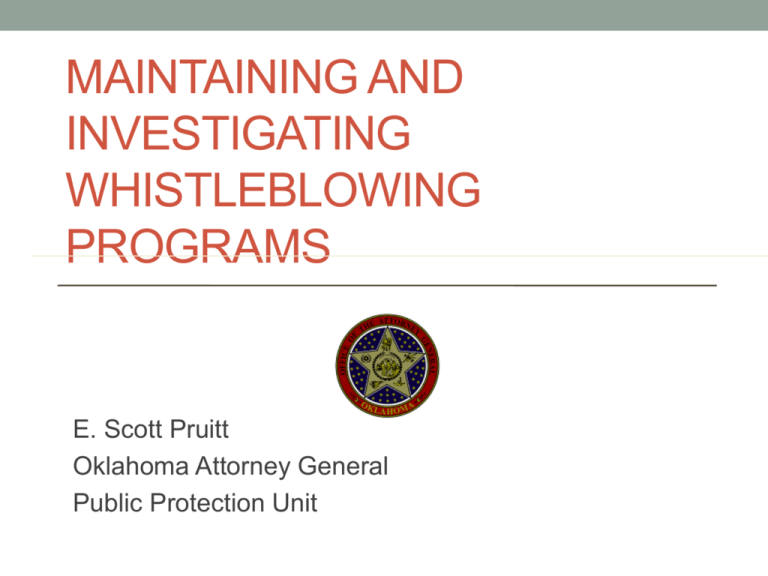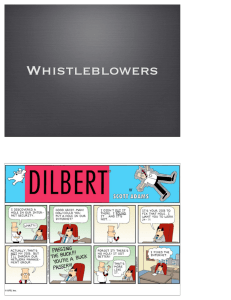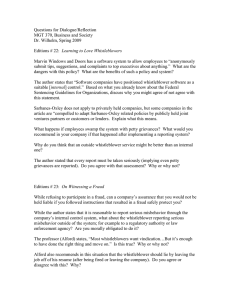Building Effective Whistleblowing Programs
advertisement

MAINTAINING AND INVESTIGATING WHISTLEBLOWING PROGRAMS E. Scott Pruitt Oklahoma Attorney General Public Protection Unit Why are whistleblowing programs important? • • • • • U.S. companies lose over $400 billion a year to fraud. Average loss per company: $2,199,930. Auditors only detect approximately 19% of all frauds. The largest frauds/bankruptcies in history occurred during the past decade. Approximately one third of American employees have witnessed unethical or illegal conduct in their workplace. Of these, over half did not disclose what they observed. • Employees typically have limited knowledge of who to contact if they become aware of inappropriate acts in the organization. • An analysis of business crises between 1990 and 2000 found that management is frequently aware of problems, and ignores them until a crisis develops or an employee blows the whistle on the activity. • Auditors cannot audit every process and transaction all the time. Some whistleblowers Employee • Cynthia Cooper • Sherron Watkins • Dr. Jeffrey Wigand • Randy Robarge • Keith Schooley Organization Regarding/Results WorldCom Enron $104 billion bankruptcy $63 billion bankruptcy Brown & Williamson Com Ed’s Zion plant Merrill Lynch Effects of nicotine Radioactive materials Management misconduct What has been done about it? • • • • • SEC, NYSE, NASDAQ regulations enhanced At least 13 other related pieces of legislation passed in history At least 47 states have laws protecting whistleblowers Federal Sentencing Guidelines Sarbanes-Oxley Act passed in July 2002 • Section 301.4: Audit Committees must establish whistleblowing programs • Section 806: Protection for whistleblowers at public companies • Section 1107: Penalties for retaliation Impact of Dodd-Frank Act • May 25, 2011, the SEC adopted rules to implement Dodd• • • • Frank’s whistleblower program. Dodd-Frank requires the SEC to pay whistleblowers between 10-30 % of monetary sanctions exceeding $1million received for violations of securities laws. Whistleblower must voluntarily provide original information concerning the violation. This type of program creates monetary incentives for whistleblowers to bypass internal reporting programs and go directly to the SEC. More important for companies to have meaningful internal programs to receive and respond to reports from whistleblowers. Key Factors for Success • Accessibility The program must be accessible easily and cheaply to all employees through multiple channels • Strong and Consistent Tone at the Top Management must send clear and consistent messages of what is expected of all employees • Strong Support Network Whistleblowers need support at work, home, and from peers Key Factors for Success (continued) • Build Widespread Awareness and Support • Of the program’s existence and avenues for disclosure • Of support from Management and Board of Directors • Of the connection to the organization’s Code of Ethics Development Phases 1 Assessment Evaluate Needs Establish Protocol Identify Reporting Mechanisms Select Oversight Board 2 Building Train Operators and Oversight Board Update Policies and Procedures Write Board’s Charter Define Program Release Mechanism 3 Program Release Distribute Notices Define Program Release Mechanism Meet with Employees 4 Performance Monitoring Meet with Oversight Board Review Performance Reports Survey Employees 1 Assessment Assessment 2 Building Building 3 Program Program Release Release 4 Performance Performance Monitoring Monitoring Development Phases Assessment • Geographic coverage and linguistic groups • Protocol Case Numbers Contacts Information/ID safety Reporting Response times Escalation procedures Discretion Qualifications • Avenues for disclosure Toll-free phone lines Fax Ombudsperson E-mail 1 Assessment Assessment 2 Building Building 3 Program Program Release Release Development Phases Assessment (continued) • Staffing Solution In-House Out-Source • Manager of the Program Independence Funding Qualifications Staffing • Response Team Internal Audit Legal Accounting/Finance Human Resources IT Operations 4 Performance Performance Monitoring Monitoring 1 Assessment Assessment 2 Building Building 3 Program Program Release Release Development Phases Assessment (continued) • Oversight Board Composition Meetings Responsibilities Reporting 4 Performance Performance Monitoring Monitoring 1 Assessment Assessment 2 Building Building 3 Program Program Release Release Development Phases Building • Logistics Hire staff Organize Boards Install equipment Set meeting calendar • Training Operators Board of Directors Management Oversight Board • Policies and Procedures Operating P&Ps Charter(s) Employee manual Code of Ethics 4 Performance Performance Monitoring Monitoring 1 Assessment Assessment 2 Building Building 3 Program Program Release Release 4 Performance Performance Monitoring Monitoring Development Phases Program Release • Options Face to Face Memo / e-mail Computer Training Train the trainer Video / Voice Conference • Management Participation • Employee Meetings Logistics: size, length, mandatory attendance Agenda: purpose, importance, management’s commitment, protections, professionalism, no exceptions, will investigate all allegations 1 Assessment Assessment 2 Building Building 3 Program Program Release Release Development Phases Program Release (continued) • Extent of Release Ideally all locations simultaneously Largest facilities with face-to-face meetings • Facilitator 4 Performance Performance Monitoring Monitoring 1 Assessment Assessment 2 Building Building 3 Program Program Release Release 4 Performance Performance Monitoring Monitoring Development Phases Performance Monitoring • Activities Reporting: Monthly to Oversight Board Quarterly to Audit Committee Include cycle times, totals, categories Meetings: Oversight Board at least monthly • Employee Surveys Annual, anonymous, company-wide surveys • Reminders With conflict of interest statements During annual staff meetings Risks and Challenges • Most whistleblowers suffer Harassment Alienation Discrimination Stress / emotional hardship Retaliation Intimidation Job loss / blacklisted Family hardship-divorce • Corporate culture and sub-cultures Different practices between senior management and field employees • Pressure to perform Management could, knowingly or not, send message to break rules, or employees misinterpret message Risks and Challenges • Employees do not know / forget who to contact • Post whistleblower program information prominently • Ombudsperson should be active and visible • Provide annual reminders • Preference to confide in immediate supervisor • Explain avenues if immediate supervisor is suspect • Avenues inside and outside the organization • Encourage internal disclosure to avoid public crisis Provide support, act quickly, offer feedback and reward Risks and Challenges • Include international operations • Sarbanes-Oxley 302 and 404 implications Attestation faulty if not aware immediately of irregularities in the organization • Even greater reluctance to blow the whistle Cultural differences Fewer legal protections Fear of retaliation • Negative publicity • Anti-American sentiments and safety concerns What to do when the call comes in • Information intake. • Assess whether this requires an immediate response. • Inform the appropriate parties per protocol. • Determine what additional resources are needed for preliminary conversations. • Team must assess nature and impact of allegations • Is this a fraud? Has it been substantiated? • Is the condition ongoing? Is the loss material? • How many people are involved? What to do when the call comes in • Are outside resources needed? Consider legal assessment. • Risks involved to individuals and organization. • How was the issue discovered? What to do when the call comes in • Develop an Action Plan. • What are the objectives? • What do you need to meet that objective? • What will you do with the information? • File civil or criminal charges? • Only use internally? • Who is responsible for leading this project? • Who else will be on this team, both internally and externally? • Will the suspect be contacted? What to do when the call comes in Set timeline / deadlines for investigation • Milestones dates. Manage each allegation like a project. Work systematically but be patient. • When and who will be pulled into the project? • Is there going to be a report? What will it contain? • Who will receive updates and the final report? Make sure to get competent advice regarding civil, criminal and employment law. Legal Considerations • Keep good records to protect evidence, ensure credibility and avoid claims of discrimination. • Be patient during investigation to obtain sufficient, reliable and relevant data. • Make sure evidence is collected and analyzed by someone with sufficient time, tools and expertise. • Consider obtaining private investigator or assistance from law enforcement. • Do not rush to judgment. The subject of allegation also has rights. Legal Considerations • Non-financial allegations (e.g. sexual harassment) can result in costly lawsuits if case is mishandled. • Consider total costs and whether focus is prosecution, recoveries, restitution, or termination. • Reminder that only the government can punish or prosecute. Companies discipline. • Company discipline does not result in a public record. Legal Considerations Types of investigation • • • • • • Physical surveillance Electronic surveillance Research and internal audit Forensic analysis Undercover Interviewing and interrogation Investigations require expertise, knowledge of private/public sources of data and being mindful of privacy laws/rights. Opportunities for Internal Auditors • Ask employees during audits • Be visible and active to prevent fraud • Be technically proficient to search for indicators of fraud • Be trust-worthy and become an avenue for disclosure • Be a member of the response team • Provide accounting, IT and fraud examiner expertise during investigations • Conduct independent surveys • If independent, audit the program 10-Step Audit Program 1. Review the program’s protocol 2. Examine allegation files 3. Review composition and role of the oversight board 4. Verify the autonomy of the program 5. Review performance reports 6. Verify adequacy of the program’s budget 7. Review the employee manual and code of ethics 8. Verify access to the program 9. Confirm qualifications of the staff 10. Survey employees Goal: Corporate Environment Where • All officers and employees act ethically and produce accurate financial statements. • All stakeholders are treated fairly, with dignity and respect. • All allegations of non-compliance are investigated thoroughly, professionally and promptly. Those found guilty are disciplined quickly, firmly and fairly. • Whistleblowers receive private and/or public recognition when it is safe to do so. Summary • Whistleblowing programs require more than setting up a phone line, even if the program is outsourced. • Plan, release, monitor and get feedback. • Internal Auditors must play a key role. References Primary Source: Murdock, Hernan. Building Effective Whistleblower Programs. http://www.murdockglobaladvisors.com/About.html Secondary Alford, C. (1999). Whistle-blowers: How much we can learn from them depends on how much we can give up. American Behavioral Scientist. 43(2), 264-277. Brujins, C. & McDonald, L. (2002). Encouraging whistleblowing as a crisis prevention strategy. IFSAM 2002 Conference, Australia. Retrieved on February 10, 2003 from http://www.ifsam.org Callahan, E., & Dworkin, T. (2000). The state of state whistleblower protection. American Business Law Journal. 38, 99-108. Dawson, S. (2000). Whistleblowing: A broad definition and some issues for Australia. Working Paper. Victoria University of Technology. Economic crime survey 2003. PriceWaterhouseCoopers. Retrieved on September 9, 2003 from www.pwcglobal.com Label, W. (1999). Whistleblowing and external auditors. The Journal of Applied Business Research. 15(2), 87-92. Latimer, P. (2002). Reporting suspicions of money laundering and “whistleblowing”: The legal and other implications for intermediaries and their advisers. Journal of Finiancial Crime. 10(1), 23-29. Loeb, S. (1990). Whistleblowing and accounting education. Issues in Accounting Education. 5(2), 281-294. McDonald, S., & Ahern, K. (1999). Whistle-blowing: Effective and ineffective coping responses. Nursing Forum. 34(4), 5-13. Miceli, M., Van Scotter, J., Near, J., & Rehg, M. (2001). Individual differences and whistle-blowing. Academy of Management Proceedings. C1-C6. Persons of the Year. Time. December 30, 2002. Posner, J. (2001). Reflections of a pioneer. Employee Rights Quarterly. 1(4), 49-52. Post, J., Lawrence, A. & Weber, J. (2002). Business and society: Corporate strategy, public policy, ethics. (10th ed.). New York: McGraw-Hill. Rothschild, J. & Miethe, T. (1999). Whistle-blower disclosures and management retaliation. Work and Occupations. 26(1), 107128. Top 10 reasons why fraud is increasing in the US. Institute of Management Accountants. May 2001. Retrieved on September 5, 2002 from www.cwu.edu Zipparo, L. (1999). Encouraging public sector employees to report workplace corruption. Australian Journal of Public Administration. 58(2), 83-93. AG Public Protection Unit Contact Information Tom Bates, Chief 313 NE 21st Street Oklahoma City, OK 73105 Phone: 405-522-1015 FAX: 405-522-0085 Tom.Bates@oag.ok.gov Julie Bays, AAG Phone: 405-522-3082 Julie.Bays@oag.ok.gov Clayton Eubanks, AAG Phone: 405-522-8992 Clayton.Eubanks@oag.ok.gov Ethan Shaner, AAG Phone: 405-522-3060 Ethan.Shaner@oag.ok.gov Consumers may register complaints at www.oag.ok.gov or by calling 405-521-2029.











